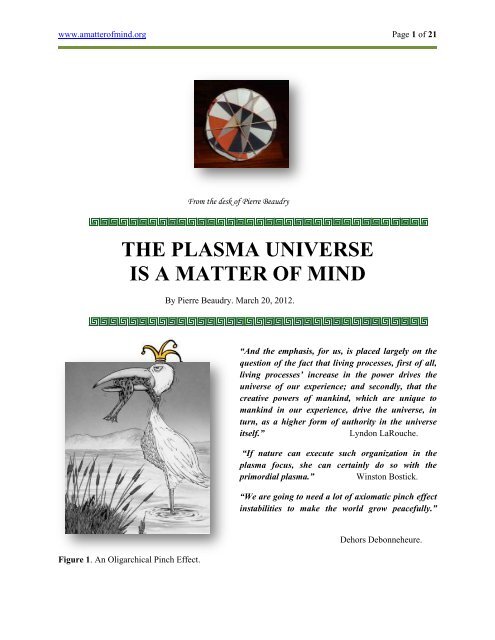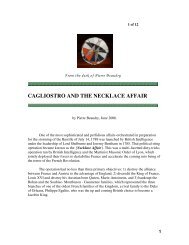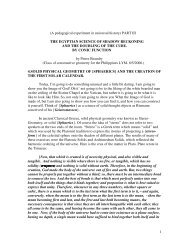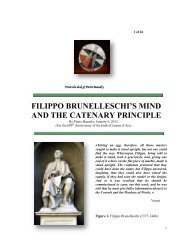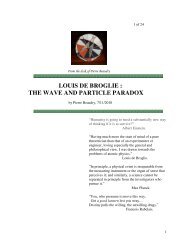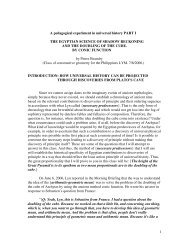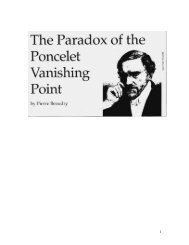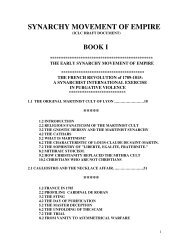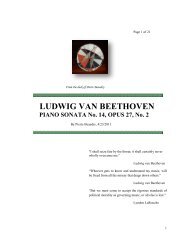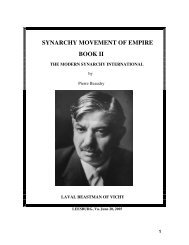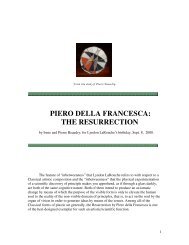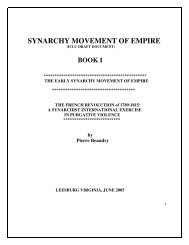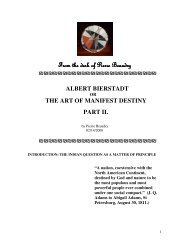THE PLASMA UNIVERSE IS A MATTER OF MIND
THE PLASMA UNIVERSE IS A MATTER OF MIND
THE PLASMA UNIVERSE IS A MATTER OF MIND
You also want an ePaper? Increase the reach of your titles
YUMPU automatically turns print PDFs into web optimized ePapers that Google loves.
www.amatterofmind.org Page 1 of 21<br />
From the desk of Pierre Beaudry<br />
<strong>THE</strong> <strong>PLASMA</strong> <strong>UNIVERSE</strong><br />
<strong>IS</strong> A <strong>MATTER</strong> <strong>OF</strong> <strong>MIND</strong><br />
By Pierre Beaudry. March 20, 2012.<br />
“And the emphasis, for us, is placed largely on the<br />
question of the fact that living processes, first of all,<br />
living processes’ increase in the power drives the<br />
universe of our experience; and secondly, that the<br />
creative powers of mankind, which are unique to<br />
mankind in our experience, drive the universe, in<br />
turn, as a higher form of authority in the universe<br />
itself.”<br />
Lyndon LaRouche.<br />
“If nature can execute such organization in the<br />
plasma focus, she can certainly do so with the<br />
primordial plasma.” Winston Bostick.<br />
“We are going to need a lot of axiomatic pinch effect<br />
instabilities to make the world grow peacefully.”<br />
Figure 1. An Oligarchical Pinch Effect.<br />
Dehors Debonneheure.
www.amatterofmind.org Page 2 of 21<br />
FOREWORD<br />
Is there proportionality between the human mind and the universe? If so, what determines it? The<br />
irony present in all galactic plasma studies is that plasma physicists have the opportunity to replicate the<br />
immense magnitudes of the galactic creative activity of the universe as a whole inside of the apparently<br />
small area of their own minds, and demonstrate how that idea works in their laboratories. Christian<br />
Birkeland, Irving Langmuir, Hannes Alfvén, Winston Bostick, and Anthony Peratt have all experimented<br />
this during their amazing discoveries of principle of the Plasma Universe.<br />
The central paradox of that principle, common to all of those scientists, is that the fusion process<br />
of the human mind is the paradigm for the behavior of the universe as a whole. They all demonstrated,<br />
each in their own way, that the universe grows anti-entropically. As a byproduct of their experiments,<br />
these physicists have eradicated from the domain of science a number of fallacies of compositions<br />
underlying the so-called “visual universe,” such as the “Big Bang” gravitational model, dark matter, and<br />
black holes. This report is aimed at emphasizing the epistemological significance of this Plasma Universe<br />
as a Matter of Mind within the following seven sections.<br />
INTRODUCTION: <strong>THE</strong> FUSION KEY TO INCREASING ENERGY FLUX-DENSITY<br />
1. A <strong>PLASMA</strong> <strong>UNIVERSE</strong> VERSUS <strong>THE</strong> SO-CALLED “V<strong>IS</strong>UAL <strong>UNIVERSE</strong>”<br />
2. A CLASSICAL ART<strong>IS</strong>TIC IRONY <strong>OF</strong> GALACTIC PROPORTION<br />
3. <strong>THE</strong> EP<strong>IS</strong>TEMOLOGICAL SIGNIFICANCE <strong>OF</strong> <strong>THE</strong> PINCH EFFECT<br />
4. A FEW H<strong>IS</strong>TORICAL HIGHLIGHTS <strong>OF</strong> <strong>THE</strong> PINCH EFFECT<br />
5. <strong>THE</strong> EVOLVING <strong>PLASMA</strong> <strong>UNIVERSE</strong> AS A LIVING PROCESS <strong>OF</strong> <strong>THE</strong> FUTURE<br />
CONCLUSION: <strong>THE</strong> SOLUTION TO <strong>THE</strong> BRIGHT-NIGHT-SKY PARADOX<br />
INTRODUCTION: <strong>THE</strong> FUSION KEY TO INCREASING ENERGY FLUX-DENSITY.<br />
The crucial question that is posed by the higher principle of a fusion process is not how to<br />
eliminate instabilities, but rather, how to control the increase of instabilities inside of the Plasma<br />
Universe. This is a proportional problem which was first established socially in 1648 as the principle of<br />
the Peace of Westphalia, which brought the solution to the Thirty Years War. The discovery of this<br />
principle demonstrated how a fusion process must universalize an axiomatic change in a manner that<br />
generates a higher level of energy flux-density for all of the nations of the world and sheds, once and for<br />
all, the oligarchical principle. Unfortunately, this principle has been either ignored or denounced since<br />
that time, explicitly, by the current crowd of British imperialists. Meanwhile, mankind must create a new<br />
clock by means of which increased time-values for higher energy flux-density must be realized,<br />
somewhere within the physical space-time range of 10¹¹ and 10¹² cm³/sec.<br />
In other words, the answer to the question of when we can have commercial thermonuclear fusion<br />
will not come until the axiomatic change of a fusion process becomes understood as a replication of the
www.amatterofmind.org Page 3 of 21<br />
unique power of change that the creative human mind is capable of accomplishing, by unifying humanity<br />
behind the same future intention of acting for the benefit of others. It is only from that vantage point that<br />
thermonuclear fusion can become feasible, commercially and worldwide. Plasma instabilities are the<br />
tickets to a future Peace of Westphalia.<br />
The condition for this future to be realized now, however, is that mankind succeeds in creating<br />
the appropriate field distortion with the sharp tongue of truth, as would a sharp knife blade inside of a<br />
Plasma Focus Apparatus. Only then, can a self-governing plasma process be replicated as the power of<br />
truthfulness that is generated from the future of mankind in mind and from all around the planet. The key<br />
to this success resides, therefore, in the elimination from this planet of the predatory function of the<br />
oligarchical principle which functions as the inverse of this process. (See Figure 1.)<br />
The answer to the question of fusion feasibility does not lie in the physical behavior of the plasma<br />
itself, but in the political will of mankind to create the ideas that will reverse the current oligarchical<br />
domination. Unless you understand the human mind, and you begin to consider the fact that human minds<br />
must go through axiomatic changes by a willful inversion of their former ways of thinking, then, the<br />
control of fusion power will not be at hand for the human species to realize its extraterrestrial mission.<br />
Therefore, the key to success resides in how you will register and experiment this idea in your<br />
own mind first; that is, from the top down and by remaining on top of it. That experiment will not require<br />
any expensive machinery, but it will require that you be on top of it all the time. So, be aware that you<br />
might have a formal understanding of that new principle, but still be under it. That will not give you the<br />
functioning principle. You might not have to use anything else but your own mind, but it has to work as a<br />
scientific plasma physics laboratory. So, unless you have sold your soul to someone else, you can<br />
experiment the fusion process, free of charge, and discover the underlying universal physical principle of<br />
the Plasma Universe with the following thought-experiment as A <strong>MATTER</strong> <strong>OF</strong> <strong>MIND</strong>.<br />
1. A <strong>PLASMA</strong> <strong>UNIVERSE</strong> VERSUS <strong>THE</strong> SO-CALLED “V<strong>IS</strong>UAL <strong>UNIVERSE</strong>.”<br />
During the first decades of the twentieth century, Swedish astrophysicist, Hannes Alfvén,<br />
hypothesized that the Universe was composed of 99.9% of ionised gas, or plasmas. This means that the<br />
universe is dominated, primarily, by electromagnetic forces rather than by the so-called Newtonian<br />
gravitational attraction of bodies at a distance. From that vantage point, a plasma universe is also based on<br />
the explicit rejection of entropy as the fundamental law of the universe. This means that whatever antientropy<br />
you can demonstrate to exist in the laboratory of your mind is valid for the universe as a whole.<br />
This is why it is necessary to gage plasma scaling magnitudes of laboratory work as the measure of<br />
change that applies to galactic phenomena like turbulent flows generated inside of air tunnels apply to real<br />
aircraft flights. One is the test case of the other.<br />
Alfvén conceived the idea of a universal proportionality between the human mind and the<br />
universe which involved the axiomatic jump of a triply-connected epistemological change in our
www.amatterofmind.org Page 4 of 21<br />
conception of the physical space-time. He suggested a scaling proportion of the universe that was based<br />
on the factor interval of 10 9 (that is 1 followed by 9 zeros), which is required among the four domains of<br />
1) Laboratory plasmas 10-¹, 2) Magnetosphere 10 8 , 3) Interstellar clouds 10¹ 7 , 4) Hubble distance 10 26 .<br />
(See Figure 2.) He further emphasized that whatever mental creative resources you can introduce into a<br />
plasma laboratory can become valid for this universal proportional expanse of the anti-entropic universe<br />
as a whole.<br />
During the second half of the 20 th Century, two plasma physicists, Winston Bostick and Anthony<br />
Peratt demonstrated the feasibility of Alfven’s new idea of a plasma universe. Bostick wrote: “If nature<br />
can execute such organization in the plasma focus, she can certainly do so with the primordial<br />
plasma.” (Winston H. Bostick, Stockholm, August 1956, Revisited, Transactions on Plasma Science,<br />
IEEE, Vol. 17. No. 2, April, 1988, p. 71.) From that moment on, plasma became the way to understand<br />
that the universe and the human mind were based on the same creative model, and so was ambiplasma, as<br />
Alfvén called the interaction between matter and antimatter. In collaboration with both Alfvén and Peratt,<br />
Bostick made the following crucial demonstration in 1986:<br />
“A 32-year-old hypothesis of the formation of barred-spiral galaxies (Bostick 1957, 1958,<br />
1986; Laurence, 1956) which become coherent-self-exciting homopolar generators (my<br />
emphasis) has recently gained confirmative support from 3-D, particle-in-cell computer<br />
simulations (Nielsen et al. 1979; Buneman et al. 1980; Peratt et al. 1980, 1984, 1986). Such<br />
galaxies should be able to convert an appreciable fraction, f, of the energy from their<br />
gravitationally-collapsing plasmas to coherently-increasing magnetic energy via their coherent,<br />
self-exciting, homopolar-generator action (my emphasis). The following simple calculation<br />
shows that the resulting mutually-induced magnetic repulsions (Len's law) between neighbouring<br />
galaxies are greater than the gravitational attractive forces between the galaxies. The observed<br />
expansion of the Universe can be thus simply accounted for without recourse to the ‘Big Bang’<br />
hypothesis, with its unaccounted-for mysteries. (W. H. Bostick, The Hubble expansion as<br />
ascribed to mutual magnetic induction between neighbouring galaxies, Cambridge Journals<br />
Online, 1988, Volume 6, Issue 03, Stevens Institute of Technology.)<br />
This meant that the plasma studies in the laboratory became the new measure by means of which<br />
one could judge what sense-perception was not able to establish scientifically with its bundles of<br />
contradictory evidence. As for the Big Bang theory, Alfvén had already dismissed it as a myth created by<br />
a Belgian priest, Abbé Georges Lemaitre, in order to explain creation. “I was there when Abbé Georges<br />
Lemaitre first proposed this theory […] He said in private that this theory was a way to reconcile science<br />
with St. Thomas Aquinas’ theological dictum of creatio ex nihilo or creation out of nothing.” (Hannes<br />
Alfvén (1908-1995), The Royal Institute of Technology, Stockholm. Extracted from Anthony L. Peratt,<br />
'Dean of the Plasma Dissidents', The World & I, May 1988, pp. 190-197. )<br />
By 1986, the time had come to abandon the fallacies of the so-called “visual universe.” The<br />
mental conditions of the experimental phenomenon were becoming an integral part of experimentation,<br />
and the laboratory work on plasmas was becoming the new standard for science as a whole. That was the<br />
year when Hannes Alfvén caused a paradigm shift to take place with an axiom busting paper entitled,<br />
Model of the Plasma Universe. He wrote:
www.amatterofmind.org Page 5 of 21<br />
“An attempt is made to construct a model of the ‘plasma universe’ which is claimed to be<br />
an alternative to the traditional ‘visual universe’ based mainly on observations in the visual<br />
octave. Besides the Hubble expansion, there is also a ‘knowable expansion,’ which means that<br />
knowledge originating from plasma experiments in the laboratory is spreading to the<br />
magnetospheres and, it is predicted, sooner or later, will also penetrate astrophysics in general.”<br />
(Hannes Alfvén, Model of the Plasma Universe, IEEE transactions on Plasma Science, Vol. PS-<br />
14, No/. 6, December 1986., p. 629.)<br />
The implications of what Alfvén wrote did not merely relate to the new spectrum of the Plasma<br />
Universe which ranges from gamma and X-rays, which are the wavelengths of plasma phenomena, to<br />
infrared and radio waves, but, most importantly, to the fact that our knowledge can no longer be based on<br />
sense perception. This meant that aside from observing a universe based on sense certainty, we are now<br />
able to understand the real universe with more mental certainty, because our senses are merely giving us<br />
shadows of the properties that belong to the real physical universe, the Plasma Universe.<br />
The point to be made is that a Plasma Universe is a Matter of Mind not a matter of a sense<br />
perception object. This does not merely mean that the space-scales of the visual universe and of the<br />
auditory universe are different, and even sometimes contradictory in nature; it also means that the<br />
characteristics of a Plasma Universe no longer fit the metric of a “Sense Perception Universe” and that the<br />
fundamental reality that changed it was an entirely new notion of time that had never existed before. Not<br />
only was the plasma focus oriented to the future, but such a future was uniquely capable of being grasped<br />
as a means to change the past.<br />
The most immediate realization of this new “measure of time,” beyond what Einstein had already<br />
brought us with relativity, was the completely revolutionary role of proportionality that laboratory plasma<br />
studies had endeavoured to project from that moment on. It was no longer the visual universe which<br />
dominated our understanding of the universe, but the future oriented proportionality of thinking which<br />
had to go on inside the laboratory, between the scientist, the experiment, and the different anti-entropic<br />
knowledge expansions of the cosmos. From that moment on, it was that new matter of mind function<br />
which defined the nature of timing in the heavens, not the heavens which defined the nature of timing in<br />
the laboratory. This was a complete revolution in its own right. As Alfvén put it:<br />
“As there are good reasons to suppose that the basic properties of plasmas are the same<br />
everywhere, we can depict this extrapolation as a ‘knowledge of expansion’ which started from<br />
laboratory research. With the advent of the space age, which made possible in situ measurements<br />
in the magnetospheres (including solar magnetosphere, heliosphere, solar wind region) , the<br />
knowledge expansion (my emphasis) increased in strength and is now on its way to reach out as<br />
far as spacecraft go.<br />
“It is very important that it proceed further out. Indeed, astrophysics will be changed very<br />
much when (sooner or later) the knowledge expansion reaches interstellar and intergalactic<br />
regions. (my emphasis)
www.amatterofmind.org Page 6 of 21<br />
“Extrapolation of laboratory and magnetospheric research demonstrates that the plasma<br />
universe has properties that differ from those of the traditional visual universe in many respects.”<br />
(Hannes Alfvén, Op. Cit., p. 630.)<br />
Figure 2. Hannes Alfvén’s model of the creative mind in relationship with the Plasma Universe. This is<br />
how Alfvén established scientific forecasting as an integral birthright of the human mind. From Model of<br />
the Plasma Universe, IEEE transactions on Plasma Science, Vol. PS-14, No/. 6, December 1986.<br />
From the standpoint of epistemology, Alfvén was quite conscious that he was introducing a new<br />
paradigm shift into the scientific fabric of society, but he was also painfully aware that the necessary<br />
axiomatic change did not go beyond the pragmatic reaches of our spacecraft capabilities, that is, had not
www.amatterofmind.org Page 7 of 21<br />
yet included the limits of the unknown within his reach. How do you go beyond the limitations of the<br />
unknown? How do you change the time of an experiment in a way that it is not clocked against the time<br />
of a spacecraft, but against the axiomatic creative power of the human mind? Alfvén knew that plasma<br />
was the shape of the future. He understood that the transfer of knowledge between different plasma<br />
regions of the universe was the idea that was going to secure the future of mankind. In fact, that was the<br />
way the future had to become present in the every day lives of all human beings. He was able to forecast,<br />
for example, what form the future was going to have, because he had incorporated a new form of galactic<br />
time into his daily experiments, from the top down. A burst of radiation that lasted a few microseconds in<br />
the laboratory incorporated several magnitudes of 10 to the 9 th power, or 1,000,000,000 years, which is<br />
the lifetime of a quasar inside of a galaxy.<br />
Such a relationship to galactic time had never existed before in human knowledge. Consequently,<br />
Alfvén had to establish the new paradigm based on a new concept that I would identify as a relativeproportional-plasma-space-time-reversal-process<br />
that required four new conditions: 1) that plasmas are<br />
generated by both magnetic fields and electrical fields, 2) that plasmas increase their power through the<br />
pinch effect, 3) that homogeneous plasmas be replaced by inhomogeneous plasmas, and 4) that electrical<br />
currents and filamentary currents of interstellar clouds be conceptually associated.<br />
In this regard, one of the most significant contributions of Alfvén’s was to consider that<br />
interplanetary space was not a vacuum that vibrated only when a few heavy bodies like comets, planets,<br />
and stars went through it, but that it was filled with electrical and magnetic currents that vibrated with<br />
different, yet proportional resonances of the human mind, which left their non-visible signatures<br />
everywhere across the electromagnetic spectrum. His 1930 hypothesis that interplanetary space was filled<br />
with plasma electromagnetic activity was received with total scepticism from the pundits of oligarchical<br />
science, and the official scientific reaction to his creative work is still hostile to his hypothesis today.<br />
Alfven’s new orientation of axiom busting in the domain of astrophysics was aimed, among other<br />
things, at putting an end to the so-called “Great Debate,” or what had been identified as the Shapley-<br />
Curtis Debate on the “visual universe.” This debate was a typical example of the futility of sense<br />
certainty, but it still controls the podiums of our universities today. The debate took place at the Baird<br />
auditorium of the Smithsonian Museum of Natural History in Washington DC, on April 26, 1920. Two<br />
papers were presented before a large crowd of scientists and ordinary citizens on the subject of “The<br />
Scale of the Universe.”<br />
The issue was to decide whether the Milky Way represented the totality of the universe, as<br />
Harlow Shapley was arguing, or if other phenomena, such as Andromeda and other nebulae, were actual<br />
distant galaxies, which Heber Curtis advocated. The real underlying issue of the debate, however, was the<br />
question of human creativity and the creativity of the universe as a whole, but that question was never<br />
raised openly by any of the participants. At any rate, the result of the debate both contestants were<br />
considered right and wrong, but on the grounds of their mutual fallacies of composition of their visual<br />
universe. Unfortunately, the real underlying intention of the debate was left out, which would have been a<br />
great opportunity to address the role and mission of man in the cosmos.<br />
The so-called “Scales of the Universe” begged the question of the human mind as the scaling<br />
measure of the universe, but, this question was never even “perceived” by most of the participants. The
www.amatterofmind.org Page 8 of 21<br />
debate should have, at least, shown that the evidence, based on sense perception, was faulty on both sides<br />
of the debate, because they were merely debating questions of shadows projected on the wall of Plato’s<br />
Cave.<br />
Instead of using the debate for the purpose of expanding our knowledge of the universe, both<br />
parties were scrambling for crumbs of sense certainty to fill the stomach of their illusions. It was not until<br />
astronomer Edwin Hubble was able to identify a variety of stars in the Andromeda Galaxy (M31) that<br />
American citizens began to realize that there existed billions of galaxies and trillions of stars outside and<br />
behind the Milky Way. But this did not relieve our society from the blindness of the visual universe. One<br />
more time, our citizens missed a great moment of irony.<br />
2. A CLASSICAL ART<strong>IS</strong>TIC IRONY <strong>OF</strong> GALACTIC PROPORTION<br />
Imagine the following composition by Anthony Peratt (Figure 3.) as a studio portrait whose<br />
composition represents three beautiful double radio galaxies: Fornax A, 2355 + 490, and 3C315. How do<br />
you discover the different ironies that Peratt has composed into this tableau? How can you establish the<br />
connection between artistic composition and scientific discovery, as Lyn has been suggesting for the last<br />
twenty years, and maintain that outlook from the top down? Examine the following composition (Figure<br />
3.) as an irony and ask yourself what is there to know and to not know about it?<br />
Figure 3. Anthony L. Peratt, Double Radio Galaxies, in Plasma Cosmology, Los Alamos National<br />
Laboratory, 1986.
www.amatterofmind.org Page 9 of 21<br />
How do you know when an irony of classical artistic composition is also a matter of scientific<br />
discovery? You know it when both art and science reflect a third and higher level of knowledge, the level<br />
that Cusa identified as learned ignorance.<br />
The top row shows, from left to right, three radio telescope observations of three different double<br />
galaxies taken from three different parts of the sky and reflecting three different radio snapshots of their<br />
respective evolution. Project those cosmic auditory radio expressions with corresponding laboratory<br />
plasma simulations as shadows projected through an invisible series of transcendental phase-spaces onto<br />
the wall of Plato’s Cave. The bottom row shows the computer simulations of a single laboratory plasma<br />
experiment at three different moments of its evolution in physical space-time. Where are the ironies in<br />
this scientific artistic composition? The first irony is located in the fact that the times of the different<br />
cosmic observations and the times of the plasma simulations coincide, as if in the simultaneity of physical<br />
eternity. This Double-Radio Galaxies portrait is like a galactic School of Athens! The different assembly<br />
of people and events are gathered from different octaves of time, but have all come to be unified in a<br />
single representation, a single unity of effect.<br />
Study this unity of effect closely in connection with the idea of time reversal inside of the<br />
composition and you will discover the significance of what Lyn has been inferring when he said that<br />
creativity is the way to address things beforehand; that creativity occurs in the future before the event of<br />
the discovery takes place. In the present case, the idea that there could be such an extraordinary<br />
correspondence between laboratory plasma and galactic plasma had been conceived by Alfvén 30 years<br />
before it was actually demonstrated to be true by Bostick and Peratt. But what had not been conceived<br />
before these laboratory experiments, and still remains nebulous for many, is the fact that a dual time<br />
function of relativity and of proportionality of physical space-time was the boundary condition that held<br />
that unity of effect together.<br />
This first irony, therefore, is located in the fact that each of the two time intervals between the<br />
three different galaxies, at the top, represents a span of time of about 20 million years, while the intervals<br />
between the different moments of this unique laboratory plasma experiment, in the bottom, represents a<br />
few microseconds. When you project one set of shadows onto the other set of shadows, as if through a<br />
conical projection of millions of years long, from 10ˉ 6 to 10 26 years, everything is mapped as being the<br />
same including the proportional magnitudes of time. This is how the creative time reversal process of the<br />
human mind becomes the paradigm of galactic time, because nature’s time in a single plasma focus<br />
experiment and nature’s time in the evolution of a galaxy have the same proportion. You have now the<br />
ability to forecast what a dual radio galaxy will be like millions of years into the future.<br />
Thus, what is emerging, here, is a new concept of physical space-time which is doubly-connected<br />
to represent a new mental power of both relativity and proportionality between the subject and the object<br />
of scientific study, which has never existed before, and this is creating a new way of understanding the<br />
universe. Our knowledge of the universe has changed the universe, between the very small and the very<br />
large, as well as between the human mind and the mind of the universe. This new way of looking at the<br />
universe and at man’s intervention in the universe is what Leibniz had identified as the coincidence<br />
between microcosm and macrocosm. This is also what Cusa had identified as the necessary root of<br />
discovering the power of learned ignorance.
www.amatterofmind.org Page 10 of 21<br />
Furthermore, from this vantage point of Cusa, there is a second irony. The noise of the radio<br />
signals that are proportional between the laboratory plasma and the cosmic plasma tells you more about<br />
what you don’t know than what you do know about them; and it tells you that what you don’t know must<br />
become an integral part of the knowledge that you are required to have if you wish to understand the<br />
universe as a whole. The shape of that new knowledge of the universe, which includes what you don’t<br />
know about it, is the actual curvature of the future.<br />
The idea of including your ignorance within your knowledge is not a spurious matter. It is an<br />
essential component for any one who wishes to deal with a Plasma Universe, that is, with the galactic<br />
domain. The point is that the plasma domain is one of those few areas of knowledge which demand that<br />
you go beyond your native sense perception and engage in creating new perceptors for the purpose of<br />
discovering the unknown. For example, when scientists began to inquire about the noise coming from far<br />
away galaxies that people picked up on radio waves, they began to realize that new instruments like radiotelescopes<br />
of Green Bank West Virginia (NRAO) were required to interpret these strange signals. So, a<br />
whole array of new technologies were created in order to push the boundary condition of human<br />
ignorance a little further out.<br />
Moreover, this is the way to approach the question of antimatter, for instance, because antimatter<br />
first manifests its existence by not being there, by demonstrating its contrariness to matter because we do<br />
not have, yet, the appropriate perceptors to identify it, and because we have been brainwashed into<br />
thinking about antimatter in the oligarchical form of elementary building blocks. That is a lot of nonsense<br />
because, as a result, man cannot understand why antimatter cannot be perceived. So, to clarify this point, I<br />
propose that you consider the unknown of the future in the following triple manner:<br />
The unknown takes three general forms: the first unknown is not known because it is not yet<br />
known, the second is not known because it is ignored, or is prevented from being known, and the third<br />
is not known because it is incomprehensible. Antimatter energy is of the first category, Fusion energy<br />
is of the second, and God the creator is of the third. Our job is to understand the nature of all three, as<br />
if by a single pinch effect; that is to say, by unblocking the second in order to make way for the first to<br />
become known from the intention of the third.<br />
However, bear in mind that the more you know about the universe, the more you must realize<br />
how little you know, because after you have made a new discovery of principle, there remains even more<br />
unknown than before, and although there will always remain a greater part that remains to be known,<br />
through the discovery of new perceptors, the most important part of the unknown will remain unknown to<br />
us because our mental apparatus must understand it as incomprehensible. This is, above and beyond all<br />
perceptors, the most important insight that Cusa provided for us to understand learned ignorance.<br />
In other words, Cusa provided us with a beryl lens to scrutinize the creative physical space-time<br />
magnitude of the human mind, which must be used if we are to go through Plato’s Cave from laboratory<br />
plasmas to organized thermonuclear fusion in the cosmos, and from there to organized matter-antimatter<br />
interaction, and to a higher organization of the universe beyond. That mental lens makes you discover<br />
both relative and proportional processes of physical space-time in the simultaneity of physical eternity.<br />
This is what Lyn inferred when he said: “So mankind, by discovering something, is actually creating<br />
something. By discovering something which is a principle, we apply it, because it is a principle. And by
www.amatterofmind.org Page 11 of 21<br />
applying a principle which was not known to us earlier, we change the universe, wilfully.” (Lyndon<br />
LaRouche, NEC Meeting for Tuesday, March 13, 2012.)<br />
The Peratt irony of creative time is such a doubly-connected arrangement: it is relative in the<br />
vertical manner (top down) and it is proportional in the horizontal manner (from the future to the past).<br />
The two times interconnect with each other at 90º. For example, the time it took to generate the left<br />
galaxy corresponds to about 20 million years after the first interactions between the two original clusters<br />
began to interact, and the time of the laboratory plasma burst corresponds to a few microseconds. As time<br />
increases toward the right of the composition, the intervals between each computer simulation represent<br />
proportionately 20 million years later. Again, the irony is that you can determine 60 million years of<br />
galactic time, from the top down, and identify their changes reasonably well, relative to a time lapse of a<br />
few microseconds, and without having to leave your laboratory; that is, if you are on top of it. The shape<br />
that this dual-time takes is the ubiquitous lapse of creative time: being there and being here at the same<br />
time, universally and locally in a relative-proportional-plasma-space-time-reversal-process. Such is the<br />
time of the simultaneity of physical eternity in a Plasma Universe.<br />
3. <strong>THE</strong> EP<strong>IS</strong>TEMOLOGICAL SIGNIFICANCE <strong>OF</strong> <strong>THE</strong> PINCH EFFECT<br />
“On the same time scale on which the stability is lost, the pinch is heated.”<br />
Winston H. Bostick.<br />
When Benjamin Franklin made his first experiments with a kite connecting with the plasma<br />
pathway of a thunderbolt, he was not merely teasing the electrical sky; he knew in advance what was<br />
going to happen, even though it had never happened before. Franklin was setting an example for future<br />
generations by demonstrating that man had the Promethean mission to master the Plasma Universe<br />
through understanding the significance of the pinch effect.<br />
The most successful approach from among all of the Fusion experimental methods in Fusion<br />
research, today, is the Plasma Focus approach that has been developed extensively by a former member of<br />
the Fusion Energy Foundation, the deceased Winston Bostick, who was one of the first physicists to<br />
develop the concept of a Plasma Focus Apparatus with associate scientist, Vittorio Nardi, starting during<br />
World War II.
www.amatterofmind.org Page 12 of 21<br />
Franklin at Benjamin West’s house.<br />
Benjamin West’s portrait of Benjamin Franklin.<br />
Figure 4. Benjamin Franklin experimenting with the pinch effect of a bolt of lightning.<br />
The Plasma Focus is the best method for understanding plasma fusion because a Plasma Universe<br />
grows by means of axiomatic changes, the same axiomatic changes that are necessary for the human mind<br />
to develop its creative powers in time. As Lyn extensively demonstrated for the human mind, a Plasma<br />
Universe axiomatic change requires a high density of non-linear singularities, and a sharp edge of truth<br />
that generates willful instabilities throughout the field of experimentation.<br />
Both Bostick and Nardi were the two original researchers to develop the hypothesis whereby<br />
controlled instabilities were the necessary components for the creation of an increase in energy fluxdensity<br />
within fusion plasmas. The whole question, therefore, comes down to how to master this type of<br />
change with the right amount of distortions confined in the plasma chamber of a Plasma Focus Apparatus.<br />
A tremendous amount of distortions or instabilities is created when the perpendicular function of<br />
what is called the Theta (θ) Pinch generates kinks that cut through the concave and the convex sides of<br />
the central inductive plasma sheet, simultaneously, Figure 5(15), in order to change the plasma to a<br />
higher level of energy flux-density through the creation of neutrons. The sausage-and-kink type of<br />
instability transforms the plasma field into a tiny plasma nodule, as in Bostick’s Figure 3 shows, and<br />
subsequently reorganizes itself into a toroidal solenoid as in Bostick’s Figure 20. (Figure 6.)
www.amatterofmind.org Page 13 of 21<br />
Figure 5. Vittorio Nardi’s Plasma Focus Apparatus. American patent of December 24, 1991. “A<br />
schematic sectional view of a cylindrical symmetric plasma focus apparatus […] It comprises inner 3 and<br />
outer 5 coaxial electrodes displaced from each other by an interelectrode gap 7. Typical values for the<br />
dimensions of electrodes are 118 mm and 138 mm axial length for the outer and the inner electrodes 5<br />
and 3 respectively, measured from the breech wall 9. Their respective diameters are 10 cm (id) and 34.3<br />
mm (od). The electrodes have respective muzzle ends 11 and 13 at which the current sheet 15 forms<br />
during operation of the apparatus. A sleeve 17 of electrically insulating material such as alumina or pyrex<br />
is disposed between electrodes 3 and 5, closely encircling (to within industrial tolerances of about I mm)<br />
the inner electrode 3.” (Vittorio Nardi, United States Patent Number 5,075,522.)
www.amatterofmind.org Page 14 of 21<br />
A contradictory phenomenon is generated where the repulsion of opposite currents are turned into<br />
a fusion process generating upwards of 100,000 neutrons. The energy is captured and transformed into the<br />
most useful and cheap form of commercial electrical energy. The same condition applies to any other<br />
discovery of principle.<br />
Figure 6. Winston H. Bostick, The Pinch Effect Revisited, International Journal of Fusion Energy, Vol.<br />
I, No. I. These visualizations do not represent elementary building blocks, but universal forms of analysis<br />
situs preconditions of change that are about to take place and have not yet come to be.<br />
As Bostick put it:<br />
“The pinch-effect magnetic field will impart energy to the plasma by adiabatic<br />
compression (in the dynamic pinch), by shock heating, by Joule heating, and by various<br />
instability mechanisms, and that in these processes, the plasma can be expected to acquire an<br />
energy density approximately equal to that of the magnetic field.” (Winston H. Bostick, The
www.amatterofmind.org Page 15 of 21<br />
Pinch Effect Revisited, International Journal of Fusion Energy (IJFE), Fusion Energy<br />
Foundation, March 1977, Vol. I, No. I, p. 5)<br />
What Bostick is calling for is to focus scientific work on a higher form of universal action in the<br />
universe as opposed to the reductionist and oligarchical view of elementary particles as building blocks of<br />
the universe. The so-called elementary particles considered as the building blocks of the universe are a<br />
complete fallacy of composition, simply because the Many cannot rule over the One. And the point that<br />
Bostick is making is that it is the unique nature of that plasma action itself which is to proceed from the<br />
top down as a self-generating process of increasing energy flux-density in the system. This is precisely<br />
the type of axiomatic shock treatment of change that is everywhere active in a plasma universe, because<br />
its thermonuclear fusion reflects the creative process of the universe as a whole.<br />
Figure 7. Vittorio Nardi’s Plasma Focus Apparatus reflecting the process of the pinch effect increase in<br />
Energy Flux Density.<br />
Imagine that the Nardi Plasma Focus Apparatus represents a singularity for expanded antientropic<br />
processes in the universe in the same conceptual manner that the Basement Team has begun to<br />
develop the idea to a series of self-generated hyperbolic cones to illustrate Lyn’s concept of increases in<br />
Energy Flux Density. (Figure 7.) Then, such a Plasma Focus Apparatus pinch effect becomes an<br />
expression of the type of measure of change that is required to implement this type of anti-entropic<br />
process in society as a whole. Once this principle is internalized and applied socially, a commercialized<br />
form of Fusion Energy becomes feasible under the condition that the world unites politically behind a
www.amatterofmind.org Page 16 of 21<br />
New Peace of Westphalia based on a world credit system guaranteed by the Glass Steagall Act of<br />
America.<br />
Pinch effects are also the sort of instabilities known as dissonances in the well-tempered musical<br />
system. For example, Beethoven introduced such dissonances in the third movement of his Piano Sonata<br />
Opus 27. This is the most beautiful example of an axiomatic measure of change, which shows how fusion<br />
plasma has to be organized in order to gain energy as rapidly as the pinch instability produces fusion,<br />
proportionately. Very few classical artistic compositions have had the power to realize such a fusion<br />
process in the human mind. Note especially the high density of singularities in the axiomatic change<br />
occurring near the end of the third movement. The beauty of this instability is that although Beethoven<br />
inserted it near the closing of the piece, it has to be activated from the very beginning measures in order to<br />
become infectious throughout the entire piece. The One must always impregnate the Many, even before<br />
the composition begins as such. It is a matter of mind, not of sound, from the top down.<br />
Figure 8. The axiomatic singularity of the Third Movement of Beethoven’s Piano Sonata Opus 27.<br />
Measures 164-167 represent a unique classical artistic-type of pinch effect that is present throughout the<br />
entire sonata from before the initiating measures of the first movement until after the end. This is the type<br />
of singularity that should resonate throughout the future LaRouche New Just World Economic Order.
www.amatterofmind.org Page 17 of 21<br />
4. A FEW H<strong>IS</strong>TORICAL HIGHLIGHTS <strong>OF</strong> <strong>THE</strong> PINCH EFFECT<br />
The crucial question of the instability became the focus of the Fusion research work for several<br />
decades following and Bostick formulated the crucial ambiguous state of the thought experiment in the<br />
following manner: “On the same time scale on which the stability is lost, the pinch is heated. In making a<br />
practical thermonuclear machine of the pinch type, one must therefore arrange for the plasma to gain<br />
energy fast enough to overcome radiation losses, but not so fast as to destroy pinch stability in times<br />
insufficient for appreciable fusion to occur.” (Bostick, Pinch Effect Revisited, IJFE, Vol. 1 No. I, p. 14.)<br />
This was both a political and an epistemological problem of the first order, because, politically<br />
speaking, the pinch is not always successful. What Bostick described was both a practical result of plasma<br />
physics and one of the greatest mental acrobatic results of creative thinking of the 20 th Century. He<br />
compared the competing research teams as performers in a three ring circus. As he put it: “One must<br />
recognize that the pinch effect research at this moment (1956) was not a side show to CTR circus<br />
involving the stellarator, Ogra, mirror machine acts: the pinch effect was <strong>THE</strong> featured show in the<br />
MAIN RING.” (Bostick, Pinch Effect Revisited, IJFE, Vol. 1, No. I, p. 12)<br />
However, by 1963, it was “gradually conceded” for practical reasons that the research on the<br />
pinch effect was not going to succeed in accordance with monetarist timing of delivery expectation. One<br />
of the practicalities was that mathematics could not deal with turbulence. The other practicality was the<br />
idea that turbulence was an unfortunate phenomenon that had to be eliminated at every opportunity. So,<br />
the best way to get rid of turbulence was to stop the funding. As usual, this monetarist timing was wrong.<br />
That was when “the leaders of the CTR programs in various countries eventually decided that a selfpinched<br />
plasma column had no future as a CTR magnetic-confinement fusion reactor, and financial<br />
support for pinch-effect research came to be drastically curtailed and in some cases eliminated.” (Bostick,<br />
Pinch Effect Revisited, IJFE, Vol. I, No. I, p. 16.)<br />
This is when the funding began to flow out of the pinch effect research to go into the Tokamak<br />
concept and shifted the orientation towards eliminating the instabilities instead of controlling them.<br />
Shutting down funding for the Center for Turbulence Research was an axiomatic mistake. The error was<br />
to refuse to recognize that the function of turbulence in nuclear physics was the analogue of an axiomatic<br />
shift in economics. During his entire career, American physicist Richard Feynman had identified<br />
turbulence as “the most important unresolved problem of classical physics.” Half-joking on the matter of<br />
turbulence, Feynman reported to the British Association for the Advancement of Science: “I am an old<br />
man now, and when I die and go to heaven, there are two matters on which I hope for enlightenment. One<br />
is quantum electrodynamics, and the other is the turbulent motion of fluids. And about the former I am<br />
rather optimistic.” (Parviz Moin and John Kim, Tackling Turbulence with Supercomputers,<br />
http://www.stanford.edu/group/ctr/articles/tackle.html ) Moreover, the Russian side of the pinch effect<br />
history still remains to be written.
www.amatterofmind.org Page 18 of 21<br />
5. <strong>THE</strong> EVOLVING <strong>PLASMA</strong> <strong>UNIVERSE</strong> AS A LIVING PROCESS <strong>OF</strong> <strong>THE</strong> FUTURE<br />
“The intention of the future is always to change the past.”<br />
Dehors Debonneheure<br />
Consider that a galaxy is an actual living process that is generated by plasma. When in 1923<br />
Langmuir borrowed the term “plasma” from the medical domain to apply it to the galactic domain, it was<br />
not simply because the processes of ionised material were “life-like.” He realized that electromagnetic<br />
developments were processes that reflected the living principle at the level of the galaxy, and which had<br />
greater long-lived extension than on earth.<br />
Figure 9. Anthony L. Peratt, Plasma Cosmology, Los Alamos National Laboratory. 1986. Plasma<br />
simulation of a barred galaxy evolution through Birkeland filaments. The two interacting galactic plasma<br />
blobs on the upper left are 260,000 light-years apart and are being transformed into a single spiral galaxy.<br />
The ten snapshots represent a time-span of nearly 1 billion years. How time changes!<br />
The idea of a computerized simulation of a galaxy formation was developed by a student of<br />
Alfvén, Anthony L. Peratt. In 1986, Bostick updated his 1958 research paper on Possible Hydromagnetic<br />
Simulation of Cosmical Phenomena in the Laboratory under the title Experimental Study of Plasmoids<br />
in which he demonstrated that by “firing several sources simultaneously, it is possible to simulate the<br />
production of spiral galaxies and barred galaxies.” Alfvén attended Bostick’s presentation at the<br />
University of California Radiation Laboratory, Livermore, California, and during the discussion period he<br />
asked Bostick if he could “find a relevant criterium for the existence of plasmoids in astrophysics.”<br />
Bostick responded by saying: “The speeds we have are comparable with the astronomical speeds; one can<br />
say that we have the same order of magnitude in the speed situation. Concerning the densities we are way<br />
out by a factor of 10¹ 5 . All these things have to be worked out more in details.” (Bostick, Experimental<br />
Study of Plasmoids , p. 98.) It was at that time that Peratt began to develop his computer simulation of a<br />
plasma experiment that replicated a spiral-galaxy from the rotation of two quasars. When scaled to the
www.amatterofmind.org Page 19 of 21<br />
appropriate cosmic magnitudes, the frame of the physical space-time laboratory simulation showed that<br />
the interaction lasted the proportional lifetimes of quasars, which are 10 8 and 10 9 years. Again, this is an<br />
irony of relative-proportional-plasma-space-time-reversal.<br />
The concept of the Birkeland amperian currents generated as force-free filaments of increasing<br />
galactic strength began with The Norwegian Aurora Polaris Expedition of 1902-1903, when K<br />
Birkeland discovered, for the first time, that aurora borealis originated from the sun as opposed to from<br />
earth, like everyone thought at the time. However, in 1986, it was Winston Bostick who discovered in his<br />
laboratory that the spiral galaxy and the barred spiral galaxy were efficient unipolar generators that<br />
transformed gravitational energy into rotational energy, and that the whole process generated everincreasing<br />
magnetic energy. As a result, Bostick showed that the magnetic forces of the galaxies were<br />
much greater than gravitation, and he concluded that “the consequent repulsive mutual magnetic<br />
induction between neighboring galaxies thus produces the Hubble expansion without recourse to the<br />
currently popular refuge of the ‘Big Bang.’”(Stockholm, August 1956, Revisited, p.71.) Bostick<br />
confirmed in laboratory what Alfvén had reported; that the “Big Bang” theory was nothing but a<br />
fallacious argument that Abbé Georges Lemaitre had concocted in 1927 in order to accommodate his<br />
theological convictions.<br />
While plasma physicists are busy examining the physical results of their experiments, they cannot<br />
help but to seek in their minds for the conducting mechanisms. Although they may often times be blinded<br />
by the details of their empirical data and their visual apparatus, they never forget that the creative process<br />
of plasmas is a matter of mind that is foraging the future. They do not live in the present, they live in the<br />
future, and, when they discover that the behavior of plasmas correlates with the great galactic processes of<br />
the past, their sense of time becomes completely transformed, because they realize that within the few<br />
microseconds their plasma takes to develop in the small, the pin-point camera of their machine projects<br />
onto the wall of Plato’s Cave the moving shadows of millions of years of galactic change into the future.<br />
This is what a laboratory plasma does: it actually projects your mind millions of years back and forth<br />
from the future.<br />
Since this idea of living in the future has never existed before as a state of existence for mankind<br />
as a whole, and its full effect on mankind has not yet been historically realized, the plasma physicist has<br />
the moral responsibility to develop in the laboratory of his own mind, and for the rest of mankind, the<br />
dynamic flow of how the future changes the past. This is how the not so mysterious self-generating<br />
process of unipolar induction works, because you afterward generate more out of it than you have<br />
previously put into it. Such is the nature of the future changing the past in a plasma universe. The reason<br />
why the future’s intention is always to change the past, and not the present, is because the present does<br />
not exist as such. From the standpoint of the future, the present is always the past, and most emphatically,<br />
the oligarchical past that must be shed from that future. And that is what has to be changed by means of<br />
this unipolar induction process.<br />
The idea of unipolar induction is best understood as Weber developed it in his 1841 paper in<br />
which he coined that name. The process consists in increasing electrical voltage through a conductor<br />
moving around a magnetic field, and inversely, through a magnetic field moving around an electrified<br />
conductor, both acting at right angle to each other. Unfortunately, modern engineers have no
www.amatterofmind.org Page 20 of 21<br />
understanding of this process at all which they attribute to the British reductionist Faraday. As a result,<br />
they don’t understand why this self-inducing energy generating process demonstrates how higher energy<br />
flux-densities are created in the universe as a whole. Bostick insisted on this point when he applied the<br />
generation of unipolar induction to the plasma focus:<br />
“The circuit (of unipolar induction) thus provides an avenue and instrumentality for<br />
Nature to engage in equipartition between rotational kinetic energy and magnetic energy. The<br />
Stevens’ experiments (Bostick 1986) with the plasma focus which shows the current sheet in the<br />
plasma focus to consist of plasma-concentrated, paired, Beltrami-like, vortex filaments, where<br />
local magnetic energy density and rotational kinetic energy densities are equalized, caught the<br />
theoreticians by surprise. To the best of the author’s knowledge, no one during the 35 years that<br />
the pinch effect had been known and the five years (1961-1966) that the plasma focus had been<br />
known predicted that such a beautiful morphological path to energy equipartition would be<br />
played out in Nature’s plasma focus theater. If Nature is capable of so easily outwitting the<br />
theoreticians in the matter of plasma focus and the pinch, there is little to prevent her from doing<br />
so in the galaxy.” (Bostick, The Hubble expansion as ascribed to mutual magnetic induction<br />
between neighboring galaxies, Laser and Particle Beams, Vol. 6 Part 3, 1988, p. 405.)<br />
Thus, since the creative process of the human mind is the paradigm of how change is determined<br />
in the laboratory of one’s mind, one may consider the following hypothesis. A future matter of mind<br />
project to be considered in laboratory might be to determine how a unipolar induction process such as<br />
generated by Birkeland force-free current filaments might be used as magnetohydrodynamic pathways for<br />
space travel between galaxies. The fuel, of course, would be tapped directly during travel time.<br />
CONCLUSION: <strong>THE</strong> SOLUTION TO <strong>THE</strong> BRIGHT-NIGHT-SKY PARADOX<br />
It is interesting to note that throughout history, most people will believe that black is<br />
white or that day is night, because of their enslavement to sense perception. In 1610, Kepler posed<br />
the following paradox: “If the universe had an infinite number of stars, wouldn’t the dark sky of night be<br />
as bright as day?” Kepler was teasing his fellow man, and more specifically the Catholic theologians of<br />
his days who had argued that the universe had to be finite and required a beginning, a boundary, and an<br />
end, in order to justify the oligarchical Theology of Thomas Aquinas. The argument was made that the<br />
universe had to be finite and bounded, otherwise an endless number of stars would light up the night sky<br />
as bright as day. Big bangs, black holes, and dark matter were also the fruits of similar, but more recent<br />
oligarchical luminary arguments.<br />
In reality, the argument was not at all based on the underlying assumption that the universe was<br />
finite, but that it was a “visual universe.” On the other hand, the paradox is immediately resolved when<br />
the real universe is understood as a finite, yet unbound creative process of “knowledge expansion,” as<br />
Alfvén had established. Moreover, when Alfvén stated that the real universe was 99.9% plasma, he was
www.amatterofmind.org Page 21 of 21<br />
not speaking of the “visual universe,” but of a universe that is predominantly a matter of mind. It is in that<br />
sense that the future is rapidly becoming the new residence of mankind.<br />
In that sense, therefore, understanding this new principle of time does not mean that man is<br />
merely required to scrutinize the electromagnetic spectrum, which accounts for the complete array of<br />
living radiations that galaxies emit before stars are ignited into visible light, and after they have faded<br />
from visible sight. Man must also, most emphatically, recognize himself as the only creature of this<br />
universe who has the God-given power of developing this top down relative-proportional-plasma-spacetime-reversal-process<br />
between the earth and the next anti-entropic horizon of the heavens. That must<br />
become the new direction of the Noosphere. It is, therefore, man’s moral duty and responsibility to<br />
improve on building that future eternal residence from the top down, but only by remaining on top of it.<br />
FIN


